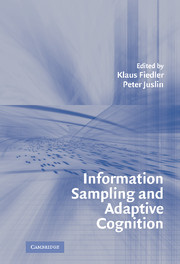Book contents
- Frontmatter
- Contents
- List of Contributors
- PART I INTRODUCTION
- PART II THE PSYCHOLOGICAL LAW OF LARGE NUMBERS
- PART III BIASED AND UNBIASED JUDGMENTS FROM BIASED SAMPLES
- PART IV WHAT INFORMATION CONTENTS ARE SAMPLED?
- 11 What's in a Sample? A Manual for Building Cognitive Theories
- 12 Assessing Evidential Support in Uncertain Environments
- 13 Information Sampling in Group Decision Making: Sampling Biases and Their Consequences
- 14 Confidence in Aggregation of Opinions from Multiple Sources
- 15 Self as Sample
- PART V VICISSITUDES OF SAMPLING IN THE RESEARCHER'S MIND AND METHOD
- Index
- References
15 - Self as Sample
Published online by Cambridge University Press: 02 February 2010
- Frontmatter
- Contents
- List of Contributors
- PART I INTRODUCTION
- PART II THE PSYCHOLOGICAL LAW OF LARGE NUMBERS
- PART III BIASED AND UNBIASED JUDGMENTS FROM BIASED SAMPLES
- PART IV WHAT INFORMATION CONTENTS ARE SAMPLED?
- 11 What's in a Sample? A Manual for Building Cognitive Theories
- 12 Assessing Evidential Support in Uncertain Environments
- 13 Information Sampling in Group Decision Making: Sampling Biases and Their Consequences
- 14 Confidence in Aggregation of Opinions from Multiple Sources
- 15 Self as Sample
- PART V VICISSITUDES OF SAMPLING IN THE RESEARCHER'S MIND AND METHOD
- Index
- References
Summary
The popular imagination owes many stimulating images to the science fiction series Star Trek. Among the more disturbing ones are the Borg, an alien life form operating “under a collective consciousness, whereby the thoughts of each drone are interconnected with all others in what is referred to as the' Hive Mind,' eliminating any sense of individuality.” The image of the Borg evokes familiar human concerns. For decades, sociologists and social psychologists sought to understand the psychology of the masses or crowds. Crowds came to be feared both for what they could do to others (e.g., lynch them) and for what they could do to the people within them (e.g., lead them toward self-destruction). Members of crowds were thought to be depersonalized as a result of the homogenization of their thoughts and behaviors (Le Bon, 1895).
In modern parlance, the idea that crowds have minds of their own is an argument regarding an emergent property. Emergent properties are irreducible; they cannot be understood with reference to the properties of their constituent elements. Social scientists studying crowds would be wasting their time trying to understand the behavior of the collective from the behavior of a sample of individuals. Nonetheless, this is what F. H. Allport (1924) proposed. He suggested that the analysis of collective behavior should begin with an analysis of individual behavior because “the individual in the crowd behaves just like he would behave alone, only more so” (p. 295, emphasis in the original).
Information
- Type
- Chapter
- Information
- Information Sampling and Adaptive Cognition , pp. 353 - 378Publisher: Cambridge University PressPrint publication year: 2005
References
Accessibility standard: Unknown
Why this information is here
This section outlines the accessibility features of this content - including support for screen readers, full keyboard navigation and high-contrast display options. This may not be relevant for you.Accessibility Information
- 14
- Cited by
